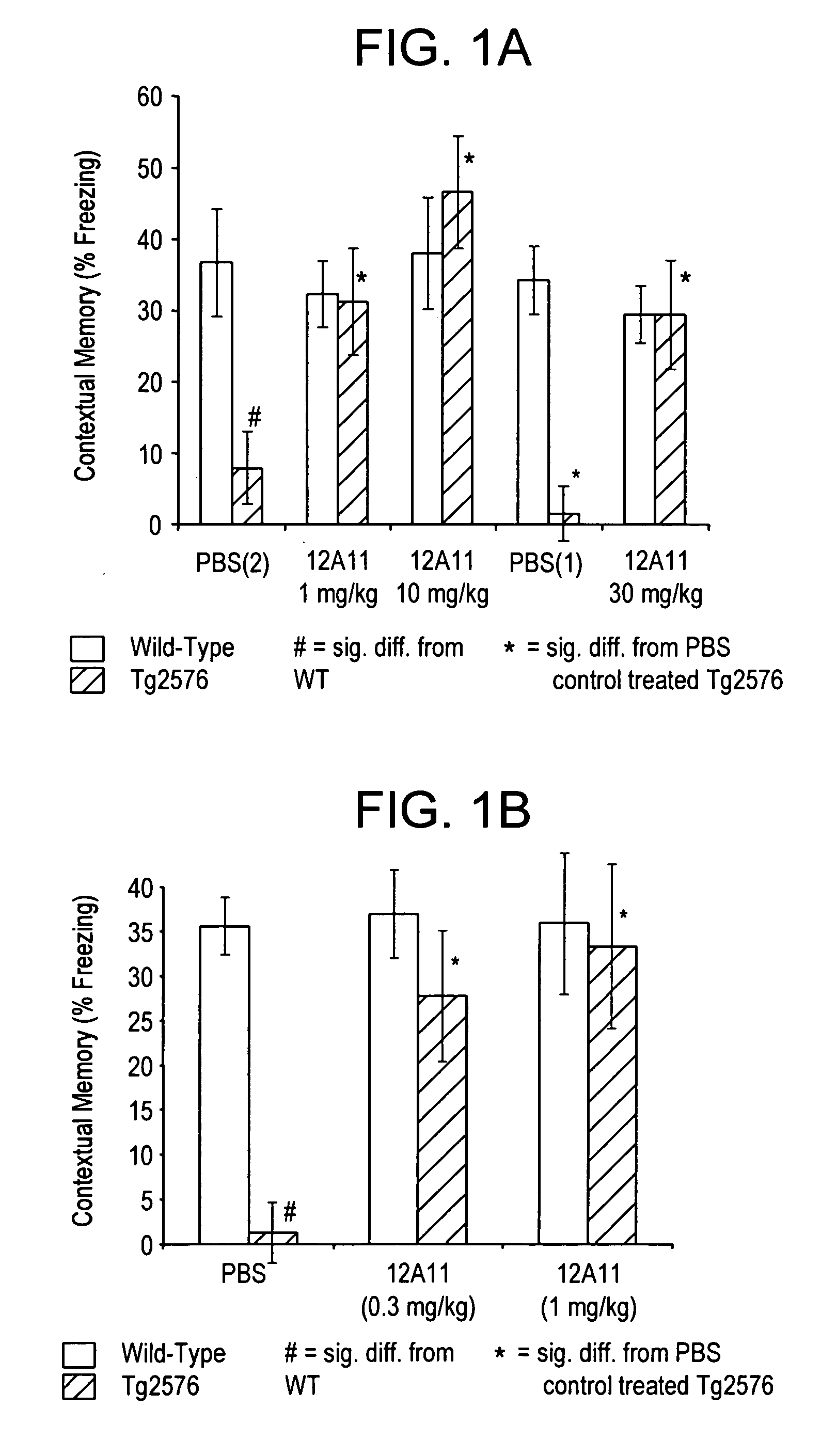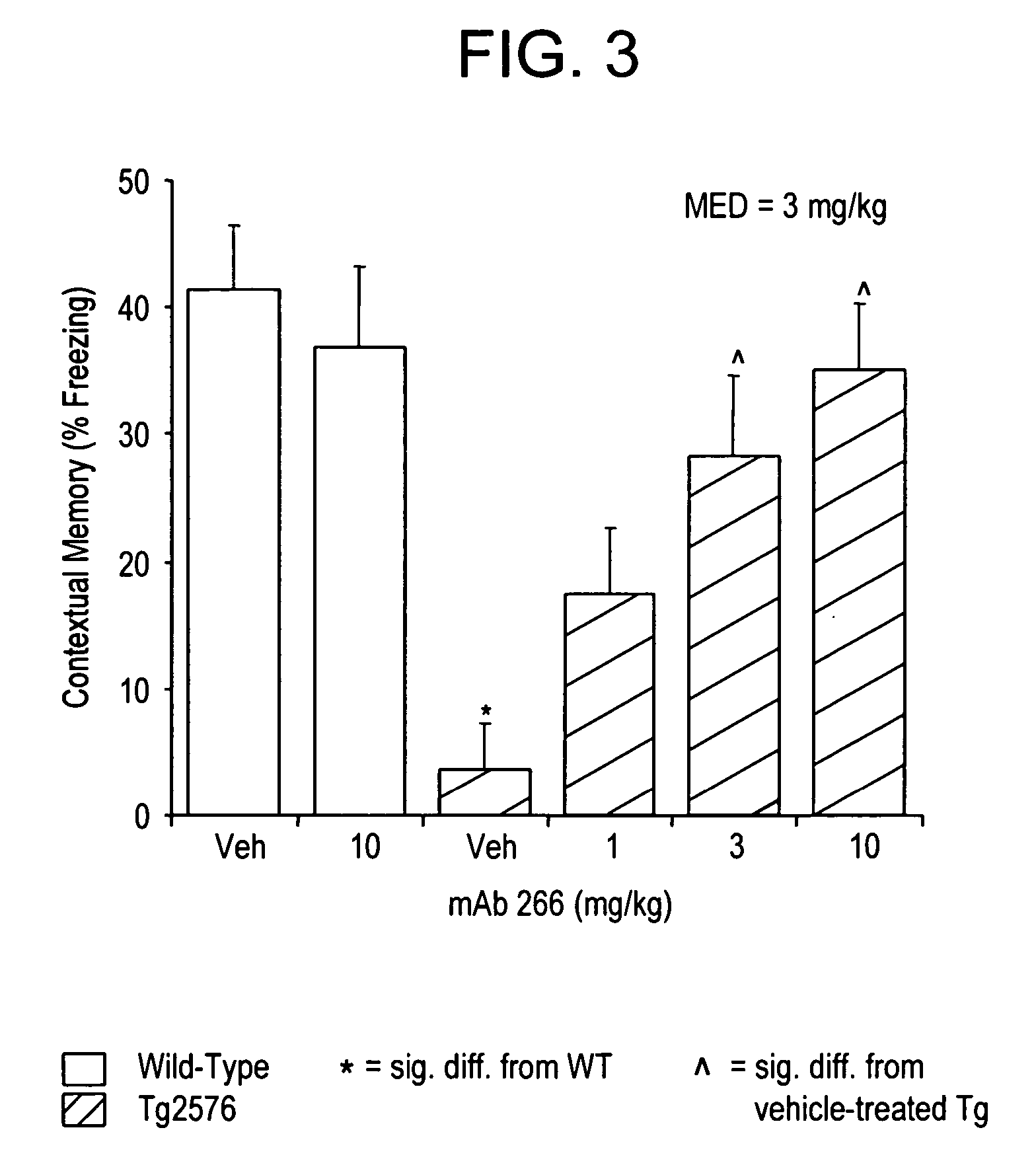Contextual fear conditioning for predicting immunotherapeutic efficacy
a technology of context and fear, applied in the field of context fear conditioning for predicting immunotherapeutic efficacy, can solve the problems of patients with dementia that require increasingly costly and intensive caregiving, cannot learn or effectively form new memories or old ones, and cannot predict the effect of immunotherapy. effect, the effect of improving cognition
- Summary
- Abstract
- Description
- Claims
- Application Information
AI Technical Summary
Benefits of technology
Problems solved by technology
Method used
Image
Examples
examples
Methods & Materials
Testing Apparatus
[0283] Transgenic mice and wild-type littermate control mice were individually housed for at least 2 weeks prior to any testing and allowed ad libitum access to food and water. CFC occurred in six 30×24×21 cm operant chambers (Med Associates, Inc) constructed from aluminum sidewalls and plexiglass ceiling, door and rear wall. Each chamber was equipped with a floor consisting of 36 stainless steel rods through which a foot shock could be administered. In addition, each chamber had 2 stimulus lights, one house light and a solenoid. Lighting, the footshock (US) and the solenoid (CS) were all controlled by a PC running MED-PC software. The chambers were located in a sound isolated room in the presence of red light.
CFC Assay
[0284] Mice (n=8-12 / genotype / treatment) were trained and tested on two consecutive days. The Training Phase consisted of placing the mice in the operant chambers, illuminating both the stimulus and houselights and allowing th...
example i
Effect of Passive Immunization with Aβ40 mAbs on Contextual Memory of the Tg2576 Mouse
[0286] Approximately 20-week old wild-type mice and Tg2576 transgenic mice were administered a single dose of phosphate buffered saline (PBS) or treatment antibody by intraperitoneal injection at 24 hours prior to the training phase of the CFC. Treatment antibodies were raised to N-terminal, central, and C-terminal portions of the Aβ peptide.
[0287] Transgenic (Tg2576) mice were heterozygous for the K670N / M671L transgene. All transgenic genotypes were confirmed by PCR and all animals homozygous for the Retinal Degeneration (Rd) mutation were excluded. The background strain consisted of a C57B16 and 129SJL cross. Tg2576 mice exhibited cognitive deficits in contextual memory beginning at 14-16 weeks of age. Cognitive deficits were particularly prominent at 20 weeks of age and were maintained up to 65 weeks of age.
Results:
i) N-Terminal Antibodies
[0288] The therapeutic efficacy of several mAbs ra...
example ii
Effect of Passive Immunization with AP40 mAbs on Contextual Memory of 18-20 Month Old, Plaque-bearing AD Mice
[0294] Wild-type mice and transgenic AD mice were administered a single dose of phosphate buffered saline (PBS) or treatment antibody (C-terminal 266 antibody or N-terminal 12A11 antibody) by intraperitoneal injection at 24 hours prior to the training phase of the CFC. The transgenic AD mice used in the experiment were approximately 18-20 months of age and displayed prominent cognitive defects, as well a dense accumulation of plaque.
[0295] Transgenic mice displayed prominent and significant reversal of contextual memory deficit when administered the N-terminal, murine IgG2a mAb designated 12A11, and this mAb was effective treatment at several low doses (3 and 10 mg / kg). (see FIG. 4). Low-dose treatment with the central terminal antibody designated 266 also resulted in a significant reversal of the contextual-memory deficit in transgenic mice. In contrast, untreated (PBS) tr...
PUM
 Login to View More
Login to View More Abstract
Description
Claims
Application Information
 Login to View More
Login to View More - R&D
- Intellectual Property
- Life Sciences
- Materials
- Tech Scout
- Unparalleled Data Quality
- Higher Quality Content
- 60% Fewer Hallucinations
Browse by: Latest US Patents, China's latest patents, Technical Efficacy Thesaurus, Application Domain, Technology Topic, Popular Technical Reports.
© 2025 PatSnap. All rights reserved.Legal|Privacy policy|Modern Slavery Act Transparency Statement|Sitemap|About US| Contact US: help@patsnap.com



